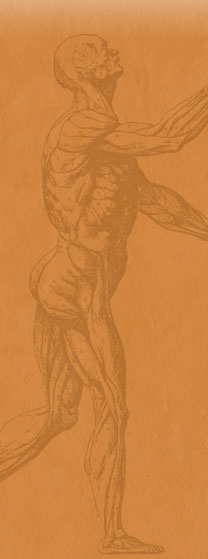 Osteopathic Approach to Patient Care and Wellness
Osteopathic Approach to Patient Care and Wellness
Osteophathic Models of Human Function: Five models of human function have been developed to provide a better understanding of the precepts of osteopathic medicine. These five models are holistic man, neurologic man, circulatory man, self-regulating man, and energy-spending man. The holistic man model can be appreciated in the concept of myofascial continuity. If we start with bone, we see that it is wrapped in the periosteum, a dense fibrous layer of connective tissue. The periosteum is then attached to fibrous connective tissues called tendons and the tendons then become continuous with the skeletal muscle fibers which are themselves wrapped in fascia. The relationship is repeated throughout the body in a myofascial attachment of one bone to another bone. In like fashion, every part of the body is attached to every other part by fascial sheaths and connective tissue glue. In between and through these attachments run the blood vessels, nerves, and visceral structures that make up the rest of the body. Wholism lies in the fascias of the body separating but also connecting every part relating it to the whole. Additionally, wholism reflects the dynamic relationship between biologic, psychoemotional, and behavioral processes. In real life, it is essentially this wholism that allow the person to recover from a life-changing event such as paralysis, mobilizing the necessary resources of body, mind, and spirit to overcome these potentially disabling challenges.
The second model is neurologic man. Neurologic function has clear segmental relationships that connect the upper limb to the neck and upper thoracic spine where the nerves come from, as well as the lower limb to the lumbosacral spine. The nerve from each spinal segment is responsible for transmitting nociceptor, mechanoreceptor, and proprioceptor impulses from the periphery and controlling motor responses in skeletal and smooth muscles. Additionally, visceral structures are connected to the same spinal segments by the autonomic nervous system. Through these many interconnections, alterations in somatic structures can influence visceral structures and vice versa. Additionally, limbic system (psycho-emotional) function influences and is influenced by somatic and visceral function. Again, structure and function are int/related and can be palpated and treated by Osteopathic approaches.
The third model is circulatory man. This concept involves the coordinated function of the respiratory and circulatory system. Normal diaphragmatic function causes changes in pressure within the major compartments of the body and is essential to the proper delivery of arterial fluids and the return of venous and lymphatic waste products to the heart. The thoracic cage contains two important diaphragms, one at the inferior and the other at the superior thoracic aperture. These diaphragms possess extensive connective tissue attachments to the muscular and bony structures that they approximate. Important neurovascular and visceral structures also traverse these diaphragms. An additional diaphragm is located in the pelvis that is made of muscle slings that also function in the same capacity to assist with respiratory and circulatory function. Optimal circulatory function throughout the body is dependent on these musculoskeletal and physiologic relations to provide the optimum movement of these important body fluids.
The fourth model, self-regulating ma,n represents the key distinction between allopathic and osteopathic medicine. In allopathic medicine, the primary focus is on evaluating and treating disease process using various external agents to influence internal function. This approach ignores the many host responses that are central to the individual’s ability to maintain optimal help and to resist as well as recover from disease. These internal mechanisms that promote health and resist disease ar/related to the integrative functions of the body as well as the unifying principle of the whole, and are all within the scope of Osteopathic diagnosis and treatment.
Finally, we have the last model of energy-spending man. Osteopathic medicine has often described the musculoskeletal system as the primary machinery of life with the viscera being termed the secondary machinery. The concept states that the heart, lungs, intestines, and other organs provide supportive processes that provide the energy for the musculoskeletal system to carry out our daily acitivities. The effects of segmental and regional motor disturbances on energy-spending man are considerable. Increased energy consumption from compensatory muscle activity and higher metabolic demand result from even the smallest injury to the lower extremities. Multiple insults of this type are constantly challenging the energy demands of the individual and compromise the available energy that may be required to perform other functions such as recuperative responses to illness and stress responses to psychoemotional demands.



